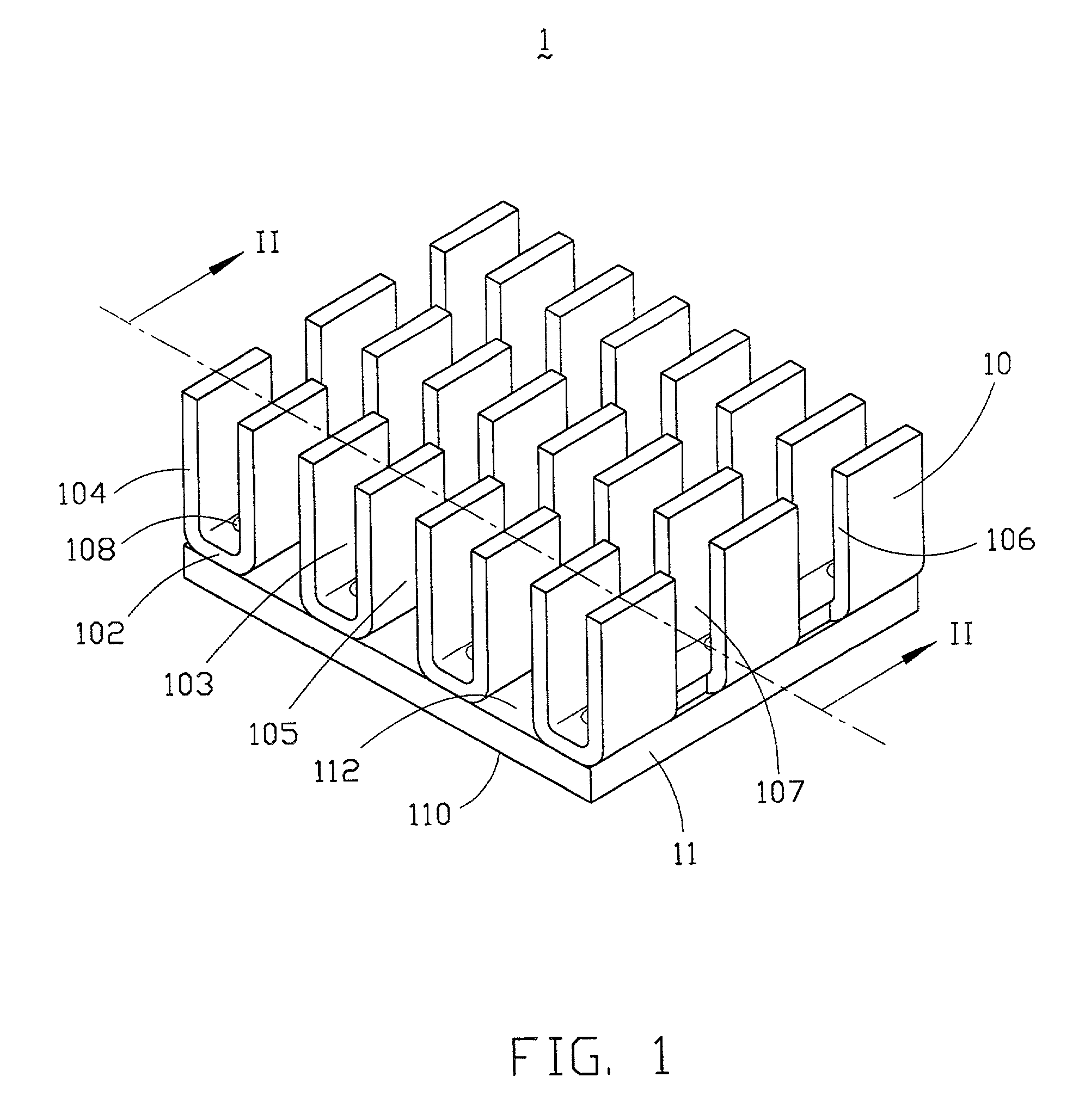Heat sink and method for making the same
a heat sink and heat sink technology, applied in the direction of lighting and heating apparatus, metal-working apparatus, semiconductor devices, etc., can solve the problems of degrading the heat dissipation capability affecting the heat dissipation efficiency of the heat sink, and unable to effectively transmit heat generated by the chip
- Summary
- Abstract
- Description
- Claims
- Application Information
AI Technical Summary
Benefits of technology
Problems solved by technology
Method used
Image
Examples
first embodiment
[0025] Referring to FIG. 1, a heat sink 1 in accordance with the present invention comprises a flat base plate 11 and a plurality of heat dissipating fins 10 upwardly extending from the base plate 11. The base plate 11 and the fins 10 are made from a heat conductive material such as aluminum and are integrated with each other by punching.
[0026] The base plate 11 has a lower surface 110 for contacting a heat generating component in a computer and an upper surface 112 for disposing the fins 10. The fins 10 are formed by shearing and bending and are arranged in rows. Each fin 10 has a U-shaped cross section forming a connecting portion in the form of a strip 102 and a heat dissipating portion in the form of a pair of opposite side walls 104.
[0027] The opposite side walls 104 of each fin 10 define a first channel 103 in a transverse direction of the heat sink 1. A second channel 105 is defined between adjacent rows of fins 10 in a direction parallel with the first channel 103. The fins ...
second embodiment
[0029] FIG. 3 shows a heat sink 2 in accordance with the present invention. The heat sink 2 comprises a base plate 21 and a plurality of parallel fins 20. Each fin 20 has an L-shaped cross section and is formed by bending. Each fin 20 includes a connecting portion in the form of a strip 202 and a heat dissipating portion in the form of a vertical wall 204. The strips 202 of the fins 20 are securely integrated with the base plate 21 by punching.
third embodiment
[0030] A heat sink 3 in accordance with the present invention is shown in FIGS. 4 and 5. The heat sink 3 includes a base plate 31 and a plurality of fins 30 formed by shearing and bending. Each fin 30 includes a heat dissipating portion in the form of a central vertical wall 304 and a connecting portion in the form of a plurality of tabs 302 extending from opposite sides of the vertical wall 304 in a staggered manner. The tabs 302 of the fins 30 are securely integrated with the base plate 31 by punching whereby the staggered tabs 302 of adjacent fins 30 are engaged with each other, as best shown in FIG. 5.
PUM
| Property | Measurement | Unit |
|---|---|---|
| heat dissipating efficiency | aaaaa | aaaaa |
| speeds | aaaaa | aaaaa |
| heat conductive | aaaaa | aaaaa |
Abstract
Description
Claims
Application Information
 Login to View More
Login to View More - R&D
- Intellectual Property
- Life Sciences
- Materials
- Tech Scout
- Unparalleled Data Quality
- Higher Quality Content
- 60% Fewer Hallucinations
Browse by: Latest US Patents, China's latest patents, Technical Efficacy Thesaurus, Application Domain, Technology Topic, Popular Technical Reports.
© 2025 PatSnap. All rights reserved.Legal|Privacy policy|Modern Slavery Act Transparency Statement|Sitemap|About US| Contact US: help@patsnap.com



